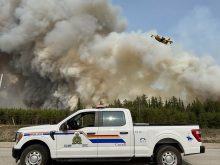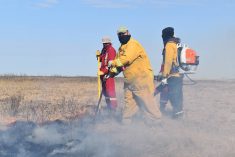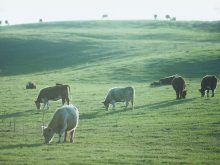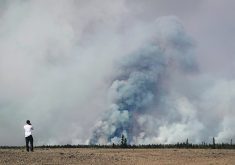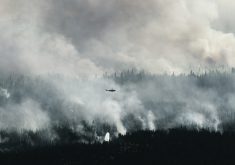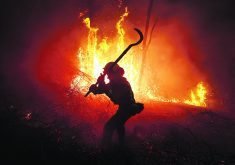Alberta public employees are being asked to volunteer to help the firefighting effort as the wildfire situation remains extremely volatile throughout central and northern regions.
Hot and dry conditions continue in many communities. Smoke is also affecting air quality and visibility throughout Alberta and Saskatchewan, and special air quality statements have been issued for both provinces.
“Our public service individuals have a wide range of experience and education. The call-out is obviously a volunteer call-out for those who would like to join in our fight against wildfires,” said forestry and parks minister Todd Loewen during a public news conference on Tuesday.
Read Also

Agriculture ministers commit to enhancing competitiveness
Canadian ag ministers said they want to ensure farmers, ranchers and processors are competitive through ongoing regulatory reform and business risk management programs that work.
They all have important jobs they’re doing now, but fighting fires on the front lines is important right now, he said.
“The widespread fires, the amount of them across the whole province, is affecting a lot of people, a lot of communities. So we’re pulling out all the stops that we can to try to get as many experienced people on the front lines as we can.”
Added Christie Tucker, Alberta Wildlife information unit manager: “This announcement certainly complements the request that has already been made to all Albertans with wildfire fighting experience to contact the email from AMA and have their skills evaluated to see how we can put them to work fighting fire.”
Tucker confirmed the province has a combined total of 2,500 firefighters working in Alberta. There are 900 from outside the province, including 60 who arrived from Ontario last week.
“One of the ways we’ve been using these additional resources coming in from outside the province (is) to assist with incident management teams and ensure that the folks out there fighting the fire are always full of energy and able to do their best,” she said.
“We have requests for a significant number more to keep up the pace because we have to plan for not only the situation that’s in front of us today, but for the situation weeks from now.”
Public employees who volunteer will be asked for their level of experience. Any upgrading to their training will also be available said Loewen.
The province will also be providing compensation for volunteers who leave their jobs to fight fires.
“We’re looking at each individual one at a time to see what their qualifications are and wherever we can best use them,” he said.
“We understand the lack of compensation for these volunteers may create barriers, as some may not be able to leave their regular jobs to join firefighting efforts or continue their selfless work. That is why the government is stepping in to remove this barrier by supporting the municipalities, First Nations and settlements being impacted by wildfires, helping them cover the costs of compensating volunteer firefighters.”
As of Tuesday afternoon, Tucker said 86 wildfires were burning inside Alberta’s forest protection areas, with 24 classified as out of control.
“So far this year we’ve responded to 472 wildfires burning 616,000 hectares,” she said.
There are no signs of reprieve from the hot and dry conditions forecast for the next three days.
However, Tucker added changing winds have been detrimental or beneficial to different wildfires depending on the location and proximity to the community.
“Happy to say we are going to be expecting some lighter wind activity. The wind will be dying down a bit today, which will be a boost to firefighters. But things can change quickly and particularly when the wind is blowing in new directions,” she said.
Evacuated farmers and ranchers are advised to call the wildfire resource line at 310-4455 with questions regarding livestock, where several agricultural and livestock societies are prepared to assist.
Alberta Beef Producers has an updated list of resources for producers facing the threat of wildfires. It can be found here.
Farmers and ranchers should also check with their municipality if there is a need to return to the land to check on livestock.
In areas of extreme smoke, it is recommended people stay inside as much as possible. Those who need to drive should check 511 for information on road conditions and closures.
Contact william.dekay@producer.com




